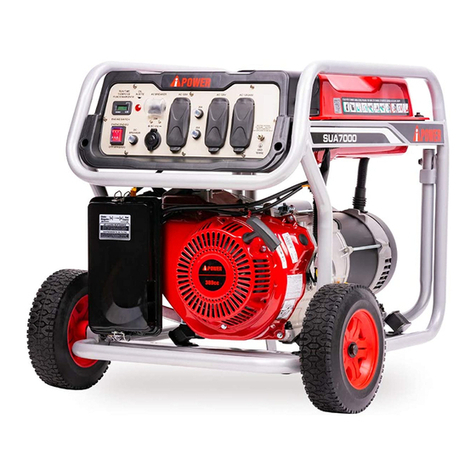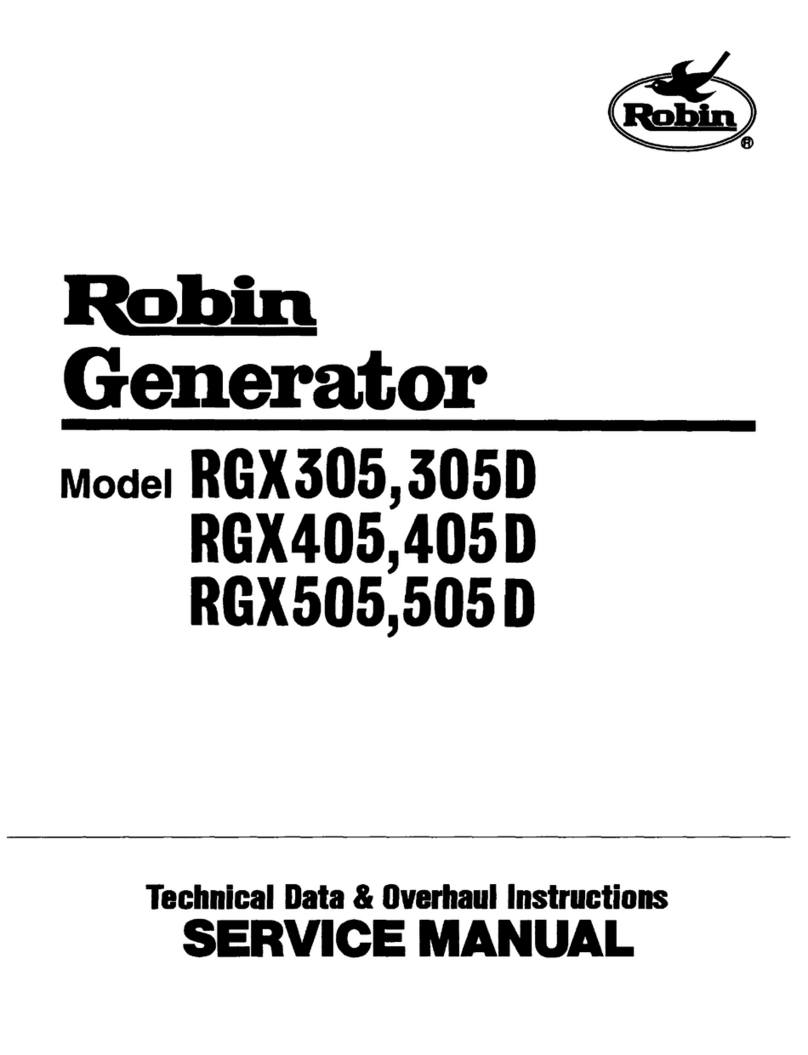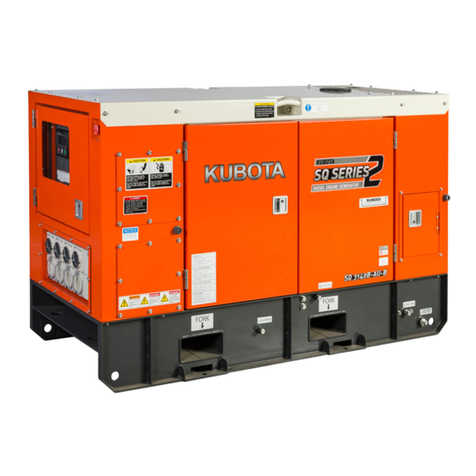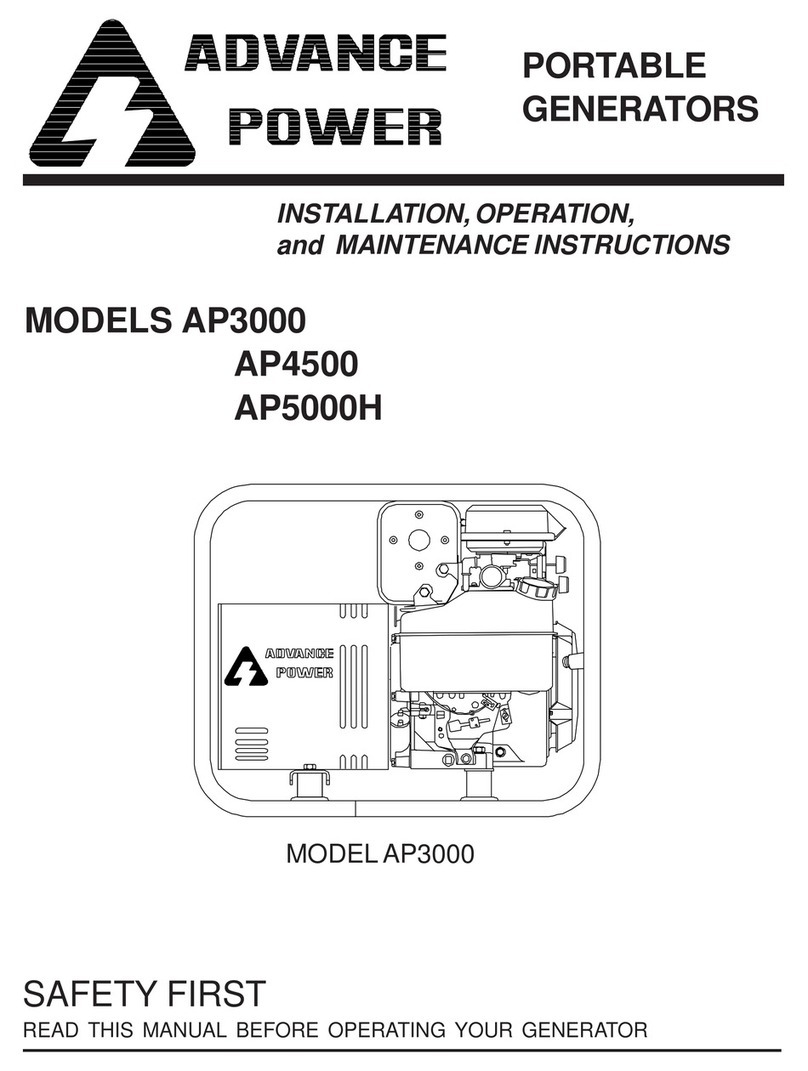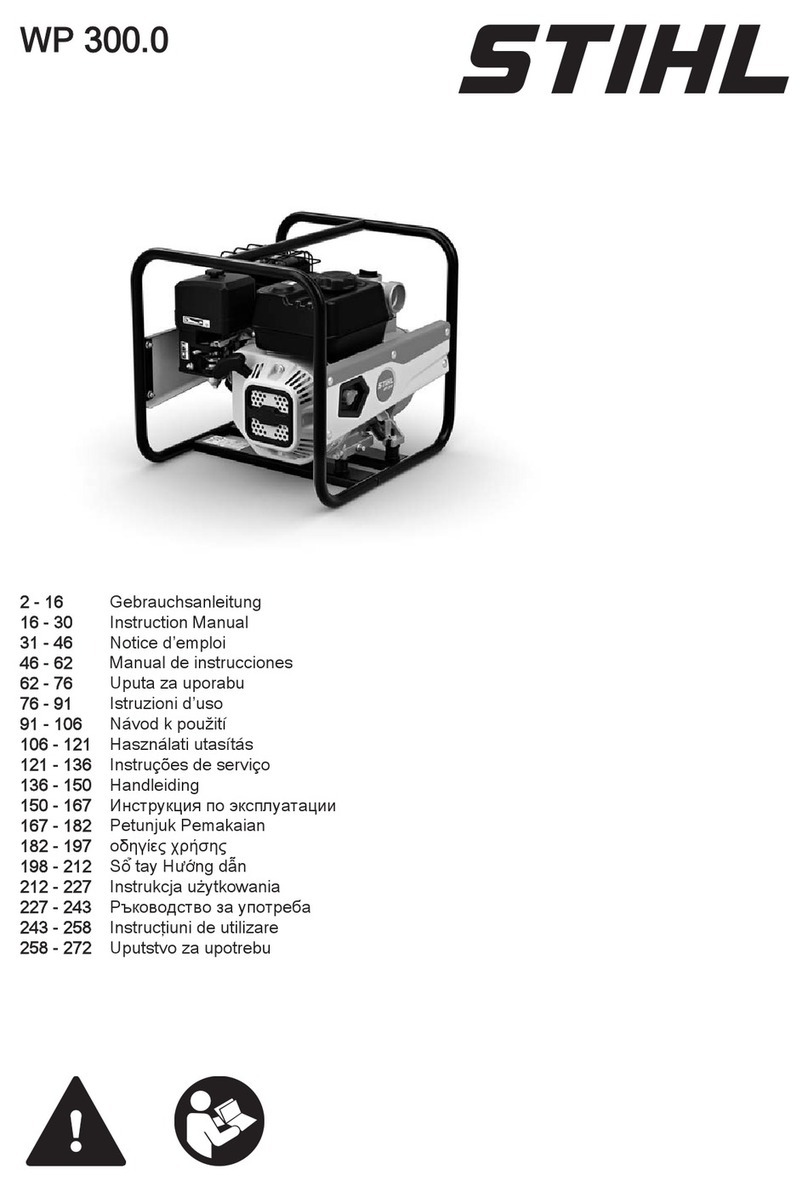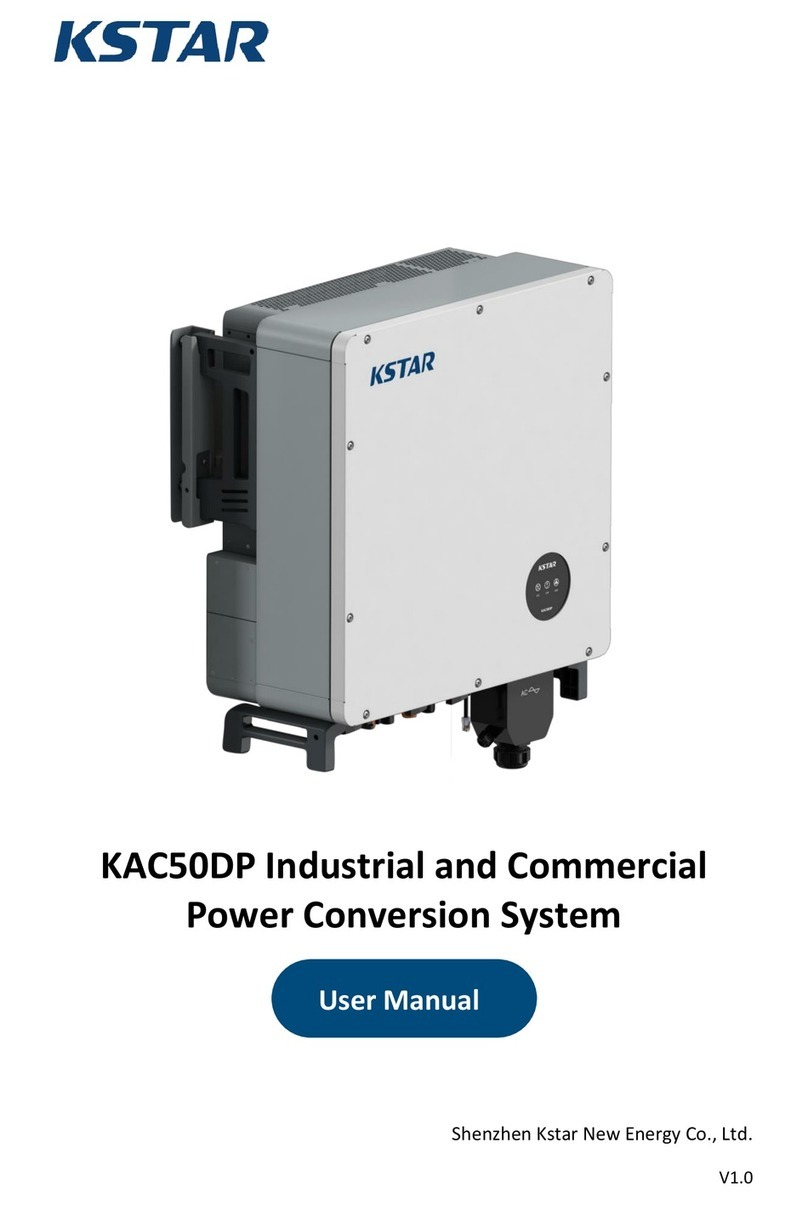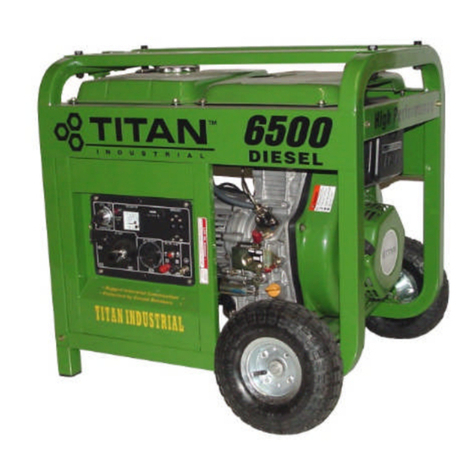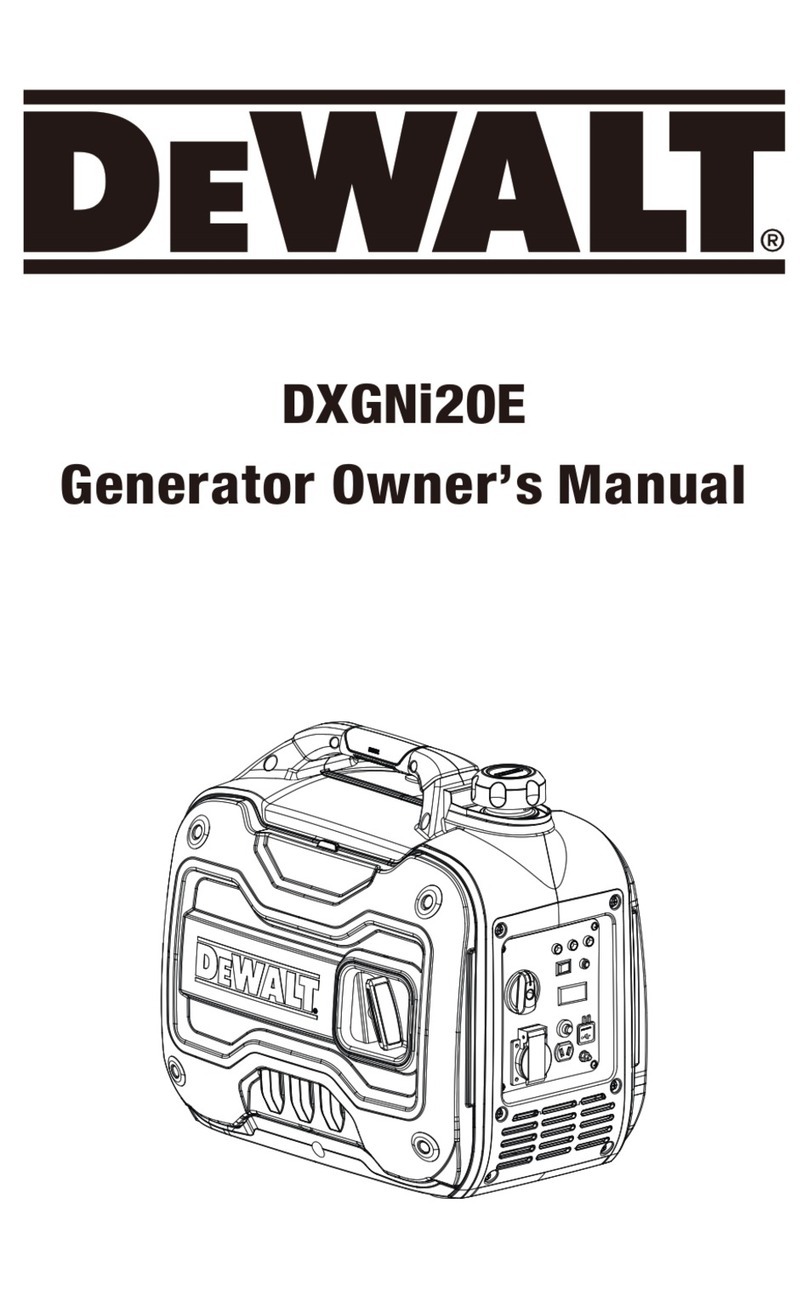CleanWater Tech Mini Series Operating instructions

Miniseries Ozone Generator Troubleshooting
FOR USE WITH CD10, CD10/AD, CD12 & CD12/AD
110613
Buy spare parts on www.cleanwaterstore.com Call us 1-888-600-5426
Email us: [email protected]
Page 1
Please run through all troubleshooting sections to insure proper operation, the
more common symptoms are listed here:
System does not turn on or off when it is supposed to. No lights are
illuminated.
•Normally the system will respond by a vacuum switch signal to turn off
and on when the vacuum of the venturi is present or not. If there is not
enough or no vacuum at the venturi the system will not respond properly.
oLook to the Gauge Readings section of this troubleshooting guide for
assistance with this issue, check for leaks and proper gauge readings
and adjust the vacuum switch if needed.
•This could be a power supply issue if the unit never turns on, as opposed
to never turning off.
oLook to the Display Lights section for assistance with no lights being
illuminated.
Some lights are illuminated, but none are ozone lights.
•This is usually a control or circuit board issue.
oLook to the Display Lights section for assistance.
Low ozone output is suspected / Crystals are pink or white in color.
•This is normally resolved with maintenance, but there are a few hardware
components to check for proper operation.
oLook to the Colored Crystals section for assistance.
Before you start:
•When adjusting or replacing components within the ozone generator, turn the system off and deny the power cord connection either at the ozone
generator or at the outlet.
•When observing operation of boards or other components with the cover removed, a cover safety switch will have to be manually triggered for
operation.
oWhen operating with the cover removed, do not come near or in contact with the white wire that connect to the top of a reaction chamber.
Do not install or remove circuit boards while the unit is powered. If the unit’s model ends in /AD, be aware that at least one of the air dryer
chamber cylinders may be very hot, do not touch them.
oLook to the inside of the cover for the peg that normally presses the switch down and install a pencil or something similar to depress the
switch to operate with the cover removed.
oIf you wish to still have display lights illuminated during operation with the cover off the unit, leave the wires connected to the cover and
simply hold it elevated, keeping sure to not touch the chassis to the upper area of the reaction chamber. Otherwise, disconnect wires from
the cover (ribbon cable from the control board and ground wire from the cover).
•Read through each troubleshooting section before performing the tests to insure the tests are performed correctly the first time.
•A multi-meter is recommended for some tests, but is not vital to troubleshooting.
Pictured is the CD12/AD, the
components of other Miniseries
systems will be similar, and are
often interchangeable.
Troubleshooting Contents:
Display Lights - These LEDs will show the current status of the system and if it is generating ozone
at this moment.
Colored Crystals - In "/AD" systems, colored silica gel crystals are visible through the cover. The
"good" color is blue. In non-/AD systems, the inline particulate filter contains silica gel
beads. We're looking for these beads to be blue in color.
Gauge Readings - If installed, the gauge assembly can tell you the air from the generator is being
drawn into the water at the proper rate. Additionally, the vacuum reading verifies that ambient air is
not blending in at any point, which would reduce the system's effectiveness.
Hardware Inspections - The end of the guide goes over inspection of important components and
inspection in the case of water damage.

Miniseries Ozone Generator Troubleshooting
FOR USE WITH CD10, CD10/AD, CD12 & CD12/AD
110613
Buy spare parts on www.cleanwaterstore.com Call us 1-888-600-5426
Email us: [email protected]
Page 2
Display Lights
The lights to focus on are the upper set of ten lights
labeled "Ozone Output" these are the usually the red
triangle lights.
If these lights are illuminated, the generator is
generating ozone*.
Confirm control of the ozone output:
•If a controller is automatically varying the ozone
output of your system, disconnect the 4-20mA
control plug (orange & purple wires) from the
unit before manually adjusting the output.
•Turn the output control knob back and forth to
cause the lights to go up and down.
oThis is the black knob, with a white stripe
located on the underside of the unit.
If you have full control of the display lights, we can
expect all the circuit boards to be functioning properly.
Move on to inspecting the colored crystals in the next
troubleshooting section.
*Note: In the Miniseries systems it is a rare occurrence to have full control of the display lights, yet you've confirmed that no ozone is being
generated. If this is the case, the transformer has failed and requires replacement. The Verify ozone generation steps in this section go over the
details to confirm no ozone is being generated
Part numbers:
ELTR100 - Transformer for single reaction chamber Miniseries system (CD10 & CD10/AD)
ELTR105 - Transformer for dual reaction chamber Miniseries system (CD12 & CD12/AD)
Troubleshooting steps:
No lights displayed
Confirm the system is powered and operational by verifying the cooling fan in the bottom left of the unit
is spinning.
If the cooling fan is spinning, it is likely the display board is either not connected or functioning.
•Turn off the ozone generator, remove the cover and reattach the LED display board in the cover to
the control board with its ribbon cable.
oBe sure all the pins on the connector make it into the proper slots of the control board.
oThere may be silicon applied on the outside of the two connections to keep it from pulling free
during shipping, cut or pull the Silicon away.
•If this does not re-establish display lights (re-verify the cooling fan is spinning), replace the LED
display board.
If the cooling fan is not spinning, we can suspect the motherboard for the unit is either not receiving power or functioning.
•Confirm the outlet the power cord is plugged into has power (using a multi-meter or another corded device).
oIf this is a wall outlet, check the Ground Fault Circuit Interrupter (GFCI) by pressing Reset on the outlet. If this trips again, we can suspect
one or both heating elements of the air dryer have been compromised. Refer to the Hardware Inspections section of this guide to verify.
oIf the outlet is an AIF box provided with an Apex package (part of the ozone installation), and there is no power, it is likely the vacuum
switch not providing the signal to energize the AIF’s outlets. Refer to the Gauge Readings section of the troubleshooting guide for steps
regarding the vacuum switch.
Display board ribbon wire
disconnected. Note: Silicon removed
Symptoms in this section
•No lights displayed
•No ozone output lights illuminated, but some lights are illuminated on lower half of the display
•Some or all of ozone output lights illuminated, but no control of ozone output
•Blinking display lights
•Ozone generator operates normally for a random length of time, and then the display lights shut off (unit turns off)

Miniseries Ozone Generator Troubleshooting
FOR USE WITH CD10, CD10/AD, CD12 & CD12/AD
110613
Buy spare parts on www.cleanwaterstore.com Call us 1-888-600-5426
Email us: [email protected]
Page 3
•Confirm the black, plastic on/off switch of the unit is switched to “on” - the switched should be pressed down on the right side.
oThe switch is located next to the power cord connection.
•Confirm the cover safety switch is depressed (even if the cover is currently on), see Before you start section earlier in the guide.
oIf the switch is suspected of being not functional, it can be replaced or bypassed by connecting its wires together.
•Confirm the fuses are healthy. There are power entry fuses located near or in the same module as the power cord connection (depending on
version), both accessed with a small flat head screwdriver. The other fuse is located at the base of the motherboard, which runs the length of the
ozone generator.
•If a fuse is popped, replace it, if any one of them pops again; replace the motherboard assuming there are no obvious shorts in the wires between
the power cord and motherboard.
oIf the motherboard fuse is popped, it is unlikely that replacement of this fuse will resolve the
issue, most of the time the motherboard will require replacement, but it there is a chance.
If power is delivered to the unit via the power cord, the on/off switch is in the “on” position, the cover
switch is depressed, and the fuses are healthy, we expect the motherboard (power supply) will need
replacement. Replace the motherboard or perform the final test to confirm.
Verify voltage is being delivered to the motherboard.
•At the bottom of the motherboard there are two 18 gauge wires, one red and one black. A green
ground wire is present between these connections in current versions of the board. Disconnect
the black wire and red wire
•Verify you have the expected (outlet) AC voltage reading on these two wires.
oThe voltage needs to be in the range of 90-260VAC 50/60 Hz.
If the expected voltage is present, the motherboard (power supply) will require replacement.
If there is no voltage present at these two wires, go back and individually test the connections and
components listed above, one of these is not functioning.
No ozone output lights illuminated, but some lights are illuminated on lower half of the
display:
Look for any red lights on the lower half of the display board. There are two
possibilities, the “EXT LOOP” and “HIGH TEMP” lights. If either of these is
illuminated, ozone output will be disabled.
The third option is the lack of the “AIR PREP” light not blinking steadily, but
instead is off.
EXT LOOP
If the "Ext Loop" (also called "external loop" and "dry contact loop") light is
illuminated, the ozone generator will go into a standby mode, no ozone will be
produced.
The external loop connection is on the underside of the ozone generator; it is a 2-
position white plug (female). It may have something plugged into it currently. More
information can be found in the Electrical chapter of the installation & operation manual.
Note: CD10 and CD12 ozone generators purchased in Apex package will normally have a jumper loop installed, this plug is supplied with the unit in
its parts bag. CD10/AD and CD12/AD purchased in Apex packages will have the external loop connected to the vacuum switch of the gauge
assembly. Perform the test below, and if the external loop light turns off, refer to the Gauge Readings section of this guide to set up airflow, vacuum
levels and adjust the vacuum switch as needed.
If the EXT LOOP light is illuminated attempt to turn it off in order to re-enable ozone output (as a test).
•Disconnect the plug currently installed into the external loop and install the external loop jumper and confirm the EXT LOOP light turns off,
ozone output should be enabled now.
oIf the jumper connection is not available, a bit of wire or a non-coated paperclip will do the same job. Note: This can be done on the ozone
generator only. Do not use a paperclip or completely bare wire in the 2-position female plug on the AIF box (if installed), this connection
will have at least 24V on it.
•If the EXT LOOP light turns off go back to the start of this Display Lights section to confirm proper operation, if there is an issue follow the new
symptom and troubleshooting steps.
External loop
connection
External loop jumper
Motherboard power input wires
Part numbers:
ELPC5054SA - Display board with ribbon cable - CD10
ELPC5050SA - Display board with ribbon cable - CD10/AD
ELPC5052SA - Display board with ribbon cable - CD12
CCA1350SA - Display board with ribbon cable - CD12/AD
CCA1325SA - Motherboard (power supply) for all Miniseries units
SWT55 - Replacement cover safety switch
FUS20 - 5Amp slow blow fuses (power entry)
FUS15 - 3Amp slow blow fuse (motherboard)

Miniseries Ozone Generator Troubleshooting
FOR USE WITH CD10, CD10/AD, CD12 & CD12/AD
110613
Buy spare parts on www.cleanwaterstore.com Call us 1-888-600-5426
Email us: [email protected]
Page 4
oIf the ozone generator operates fine, but the EXT LOOP light only turns off when manually jumped out, follow the wire normally connected
to the external loop connection and investigate why it is not closing the circuit properly. Normally this is connecting to a vacuum switch in t
he case of an “/AD” model ozone generator, refer to the Gauge Readings section of this guide to investigate airflow, vacuum and vacuum
switch issues as per the above note.
If the EXT LOOP light does not turn off when manually jumped out we have to look into possible faulty
wiring or issues with the motherboard itself.
•Disable power to the unit and open the cover of the unit. Locate and disconnect the External Loop
connection on the motherboard itself, labeled J4.
•Install a jumper connection on the two pins of the External Loop connection of the motherboard.
Turn the system back on and confirm the EXT LOOP light has turned off.
•If a jumper is not available, any metal item can be used to bridge these connections such as flat
head screwdriver.
•Note: Do not install a jumper or bridge the Fan connection pins, labeled J5. These are located
next to the External Loop connections and will have a white plug with blue and red wires installed.
Bridging the fan connection pins will cause damage to the motherboard.
oIf the EXT LOOP light turned off, go back to the start of this Display Lights section to confirm
proper operation, if there is an issue follow the new symptom and troubleshooting steps.
•Assuming there is now normal operation, examine the wire connection between the motherboard and
the white External Loop female connection on the underside of the unit for corroded connections that
can be cleaned or frayed wires that can be replaced.
•If the EXT LOOP light does not turn off after manually shorting the External Loop wiring connection
(J4) on the motherboard, replace the motherboard.
HIGH TEMP
If the HIGH TEMP red light is illuminated, ozone output will cease as an internal thermostat has tripped. Confirm the cooling fan is operating and its
filter is clean. If the cooling fan seems to be operating properly, and there is no visible heat damage to the circuit boards, then replacement of the
drive board(s) will resolve the issue.
The CD12 & CD12/AD units have two drive boards, and two HIGH TEMP lights. Remove one drive board from the unit as a test to confirm which
drive board is causing the issue and replace it. The boards have different part numbers. The middle board has tape on the heat sink and the jumper
positions on the board are different.
Part numbers:
FA47 – Replacement cooling fan for Miniseries system
FA40 – Replacement cooling fan filter (included in maintenance kit)
ELPC5040SA – Drive board for Miniseries system (only drive board in CD10 & CD10/AD - Upper drive board in CD12 & CD12/AD)
ELPC5042SA – Secondary drive board for CD12 & CD12/AD (middle board)
AIR PREP
If the AIR PREP light is not blinking steadily, but instead is remaining continuously on or off, this will require the replacement of the air dryer board.
In the case of a CD12/AD, this board also serves as the control board of the system.
Part numbers:
CCA1232SA - Control board / Air dryer board - CD12/AD
ELPC5020SA - Air dryer board - CD10/AD
External Loop wiring connection
Jumper installed on External
Loop connection
Part numbers:
CCA1231SA - Replacement motherboard (power supply) for all Miniseries
ST68SA - MTA Punch tool for connection at motherboard
ST67 - Amp pin removal tool for External Loop connection
ST65 - Amp pin crimping tool for External Loop female connection
CON125 - Amp pin, female for External Loop female connection
CON130 - Amp pin, male for External Loop male connection
ECC10 - Shorting jumper connector

Miniseries Ozone Generator Troubleshooting
FOR USE WITH CD10, CD10/AD, CD12 & CD12/AD
110613
Buy spare parts on www.cleanwaterstore.com Call us 1-888-600-5426
Email us: [email protected]
Page 5
Some or all of ozone output lights illuminated, but no control of
ozone output:
This is usually coupled with no ozone output detected when blowing air through the unit. This is a display
board issue.
•Disconnect the ribbon cable from the display board and run the system
oThere may be silicon applied on the outside of the two connections to keep it from pulling free during
shipping, cut or pull the Silicon away.
oAs the display board is disconnected, there will be no display lights.
•Listen for the high-pitched arcing noise of ozone output
•Blow air through the unit to confirm ozone output as detailed in the steps below.
•If ozone output is confirmed, look to the ribbon cable connection for bent pins, carefully bend them back and replace. If ozone output is still
not generated, or there are no bent pins, replace the display board.
oThe unit can be operated with the display board disconnected (generating ozone) while replacement parts are obtained.
•If there is no ozone output detected with the ribbon cable disconnected, disconnect and remove the control board from the motherboard.
Turn the unit on and listen for the arcing noise and blow air through the unit to confirm ozone output.
•If ozone output is now confirmed, the control board or the potentiometer that connects to it is at fault.
oThe potentiometer can be checked with an ohms resistance test (50k ohms) or both components can be replaced to be certain.
oThe unit can be operated with the control board disconnected (generating ozone) while replacement parts are obtained. Ozone output less
than 100% cannot be set.
•If ozone output is not detected with the control board removed from the ozone generator, the drive board(s) will require replacement.
oThis is assuming the cooling fan is powered and spinning, proving the motherboard is operational.
To verify ozone generation, detect the scent of ozone anywhere in the installation (e.g. the tubing connection on the contact tank’s off-gas vent).
Due to the ozone generator being “all-or-nothing” if some ozone is detected, we know that the reaction chamber and related circuitry is operational.
If we cannot detect ozone in an easy fashion, we can test the ozone generator directly by
blowing air through it:
•Disconnect tubing from the underside of the air inlet of the ozone generator; the intention
is to blow air into this fitting.
oA common location is the underside of the airflow (SCFH) gauge mounted on the
underside of the ozone generator.
oIf no gauge is installed, it will be a brass connection on the underside of the
ozone generator, in an ozone model number that ends in “/AD” it will be the left-
side brass connection we are interested in.
•Disconnect the ozone outlet of the ozone generator.
oThis is a stainless steel fitting, commonly with a grey check valve installed in this
port. Remove the check valve, as blowing air through it can be difficult.
•Apply power, enable ozone output and allow it to run for 30 seconds
•Cup your hand around the ozone outlet fitting and flow air into the brass inlet
•Detect the scent of ozone in your hand
oThe smell of ozone is sharp, sweet and can be smelled after a thunderstorm, it is often described as similar to chlorine bleach.
oIf ozone is detected, then the generator is working.
oIf there is no scent of ozone, note down all display lights, gauge readings. Write down the model and serial number of the unit, consult the
manual or contact your distributor or ClearWater Tech to continue troubleshooting.
Blinking display lights
When the output display lights of the ozone generator turn off and on in a repeating cycle, look to the gauge assembly while
this is occurring.
•If the round vacuum gauge’s needle is drifting left and right at the same rate of the pulsing of the lights, the
vacuum switch is triggering off and on due to an imbalance in the vacuum of the venturi injector and pressure of the
oxygen concentrator. See the Gauge Readings section of this guide to resolve this issue.
•If the vacuum gauge’s needle is unmoving from whatever number it is at, this is likely a circuit board issue, see the
steps below to diagnose a possible power supply issue.
Display board ribbon wire
disconnected. Note: Silicon removed
Color-coded
vacuum gauge
Ozone out here
Flow air into one
of these two points
Gauge assembly
Underside of a CD12/AD
Part numbers:
ELPC5054SA – Display board with ribbon cable - CD10
ELPC5050SA – Display board with ribbon cable - CD10/AD
ELPC5052SA – Display board with ribbon cable - CD12
CCA1350SA – Display board with ribbon cable - CD12/AD
CCA1232SA – Control board / Air dryer board - CD12/AD
ELPC5031SA – Control board - CD10, CD10/AD, & CD12
WA237 – Replacement potentiometer wire assembly - All Miniseries
ELPC5040SA – Drive board for Miniseries (only drive board in CD10 &
CD10/AD, Upper drive board in CD12 & CD12/AD)
ELPC5042SA – Secondary drive board for CD12 & CD12/AD (middle board)

Miniseries Ozone Generator Troubleshooting
FOR USE WITH CD10, CD10/AD, CD12 & CD12/AD
110613
Buy spare parts on www.cleanwaterstore.com Call us 1-888-600-5426
Email us: [email protected]
Page 6
Ozone generator operates normally for a random length of time, and then the display
lights shut off (unit turns off)
Both of these symptoms are the affect of the motherboard (power supply) shutting off or being reset repeatedly.
Usually (95% of the time) replacement of the motherboard will resolve the issue.
If replacement of the motherboard did not resolve the issue or you wish to verify prior to ordering parts, confirm one of the expansion boards is not
causing the issue.
!Read through all of the steps before performing this test.
!When disconnecting or reconnecting boards, insure the unit’s power cord is disconnected.
!When testing for operation, insure the cooling fan is spinning, proving the motherboard is powered as the display board may be
disconnected.
!The display board will not cause this issue. If it is malfunctioning it will cause odd / no lights and no ozone output, see above for details.
1. Disable power and disconnect all expansion boards from the motherboard.
a. The expansion boards slide out to the right of the motherboard; wires can be left attached to the boards.
b. A bracket is installed to the right of these boards to prevent them from shifting in shipping. This bracket will need to be removed. Securing it
is an 11/32” nut.
c. Additionally, a small amount of Silicon may be applied to the left edge of the expansion boards where they meet the motherboard. Cut or
break this connection when removing the expansion boards.
2. Power the system and observe operation; the cooling fan should be spinning.
3. If the cooling fan does not spin, confirm power is being delivered to the motherboard per the steps listed in the Display Lights > No lights
illuminated section of this guide.
a. If power is being delivered, and there is no fan movement, replace the motherboard.
4. If the cooling fan is spinning, we can assume for the moment the motherboard is healthy. It is possible that the motherboard cannot handle the
load of all expansion boards installed.
5. Systematically re-install expansion boards with associated wiring board by board. Start at the lowest position expansion board and power the
system after each board installation.
6. Confirm fan operation and new features that become available when boards are added (ex: display lights).
7. When the motherboard’s original symptoms occur (shutdown), we have found a suspect expansion board.
a. Disconnect this suspect board and continue with the rest of the systematic expansion board testing.
b. Note: If the third and final board causes the symptoms to re-appear, shut the system down and remove the lowest position board. Leave the
upper two boards installed and power the system once more. If the cooling fan and other features operate fine, our issue is not with the top
drive board. The motherboard cannot handle the full load and will require replacement.
8. Install suspect board(s) individually on the motherboard and power the system testing it alone. A return of the original symptoms confirms this
board requires replacement. The part number is printed on the board.
Part numbers:
CCA1231SA – Replacement motherboard (power supply) for Miniseries
CCA1232SA – Control board / Air dryer board - CD12/AD
ELPC5020SA – Air dryer board - CD10/AD
CCA1232SA – Control board / Air dryer board - CD12/AD
ELPC5031SA – Control board - CD10, CD10/AD, & CD12
ELPC5040SA – Drive board for Miniseries (only drive board in CD10 & CD10/AD, Upper drive board in CD12 & CD12/AD)
ELPC5042SA – Secondary drive board for CD12 & CD12/AD (middle board)
Testing sequence of a CD12/AD with wires removed for clarity

Miniseries Ozone Generator Troubleshooting
FOR USE WITH CD10, CD10/AD, CD12 & CD12/AD
110613
Buy spare parts on www.cleanwaterstore.com Call us 1-888-600-5426
Email us: [email protected]
Page 7
Colored Crystals
Blue silica gel crystals are installed in each model ozone generator. CD10/AD units also have a
chamber visible through the cover that has mixed blue and white crystals. This is at times referred to
as indicating desiccant media.
Ozone generators need to be supplied with dried air or oxygen to produce the expected amount of
ozone. CD10/AD and CD12/AD have internal air dryers for this purpose. CD10 and CD12 models
are commonly paired with oxygen concentrators.
The color of the crystals serves as a status check on the air supplying the ozone generator. There
should be no moisture present in the output of an air dryer or oxygen concentrator.
Any moisture passing through the crystals will be absorbed by the silica and produce a color change of
blue, to pink and finally to white.
A color change from blue to pink or white indicates a possible failure of the air dryer or oxygen
concentrator and will severely reduce ozone output.
•CD10/AD and CD12/AD systems: Perform the recommended annual maintenance. Replacement of the air dryer media and all indicating media
is a part of this maintenance. Instructions are included with the kit.
oIt is recommended to inspect the air dryer hardware as per the Hardware Inspection section of this guide.
•CD10 and CD12 systems: perform the recommended annual maintenance to the ozone generator in addition to inspecting and verifying the health
of the associated oxygen concentrator. Information is available in the associated manual and our website www.cwtozone.com
Gauge Readings
Most Miniseries systems have gauge assemblies installed, they are included in all Apex packages. If the installed
ozone generator does not have a gauge assembly, it can be added on.
A gauge assembly will let a user know two things:
1. Optimum ozone output will be obtained when the vacuum and airflow readings are in their ideal ranges.
2. A proper vacuum reading will show the gas being drawn from the ozone generator is flowing into the water. To
clarify: There is no air leak causing ambient air to be drawn into the water instead of ozone.
First, note the current gauge readings during operation (water pumping through the venturi, generating vacuum).
•The round vacuum gauge’s needle should be in the green range (-3 to-8”Hg). The vacuum switch has a set point of -3”Hg
oIf the needle is to the left of -3”Hg, ozone output is expected. If the airflow reading (see next step) is also in the correct range, the venturi
injector plumbed into the waterline is creating suction. The gas flowing out of the ozone generator is getting into the water.
"If the needle is to the left of -8”Hg (out of green and into red), move the needle back into the green range by opening the black knob at the
base of the adjacent airflow gauge.
oIf the needle is to the right -2”Hg and possibly in the red positive range, there is either not enough suction at the venturi, there is an air leak
or in the case of a positive reading - no suction at all. See the steps below for setting up the airflow for the ozone system to isolate the issue.
oIf the needle constantly moves left and right, either the vacuum break assembly does not have enough water within it (see notes on the
vacuum break below) or the suction generated by the venturi is not enough to overcome the pressure on the output of the oxygen concentrator.
See the steps below for setting up the airflow to balance the system.
•The airflow gauge’s floating ball ideal reading will depend on the ozone generator model. Too high or too low readings will result in less ozone
or effectiveness in the water.
oCD10 & CD10/AD have an airflow range of 3-4 SCFH the optimum is 4 SCFH
oCD12 & CD12/AD have an airflow range of 6-8 SCFH the optimum is 8 SCFH
Inline particulate filters
The original blue and two colors
that indicate a nonfunctioning
air preparation system
Gauge assembly including
vacuum switch
In this section:
•Steps to set up or recalibrate airflow for the ozone system
•No suction at the venturi injector
•Finding an air leak
•Resetting the vacuum switch
Part numbers:
ASP111B - CD10 annual maintenance kit
ASP110B - CD10/AD annual maintenance kit
ASP112 - CD12 annual maintenance kit
ASP115A - CD12/AD annual maintenance kit
DES12 - Individual bag of air dryer media
DES16 - Individual bag of mixed blue & white indicating media
FLT34 - Replacement inline particulate filters

Miniseries Ozone Generator Troubleshooting
FOR USE WITH CD10, CD10/AD, CD12 & CD12/AD
110613
Buy spare parts on www.cleanwaterstore.com Call us 1-888-600-5426
Email us: [email protected]
Page 8
Steps to set up or recalibrate airflow for the ozone system:
Notes: If the gauge readings show the needle in the green range and the SCFH ball is in the range
appropriate for the ozone generator, these steps are unnecessary. It does not matter what steps
were involved in achieving the gauge result, the steps below are one way of achieving them.
Steps following the #symbol are intended for installations using an oxygen concentrator.
#Disconnect the braided oxygen tubing from the bottom of the gauge mounted underneath the ozone
generator.
•Turn on water flow through the venturi injector and look to the airflow (floating ball) gauge on the
underside of the ozone generator. Turn the black knob counter-clockwise (open) completely; the needle on the round gauge should be at zero
due to no restriction.
oThe floating ball will show how much airflow is being generated by the suction of the venturi.
•Adjust only the bypass valve at the venturi injector to raise or lower the airflow gauge’s floating ball to just above our target airflow. We want
to generate suction above our target airflow rate.
oCD10 & CD10/AD adjust only the injector bypass valve until 6-7 SCFH displayed on airflow gauge
oCD12 & CD12/AD adjust only the injector bypass valve until 10-11 SCFH displayed on airflow gauge
oIf the airflow gauge’s ball remains at zero no matter the adjustments, proceed to the section regarding No suction at venturi. Afterwards,
return to set up airflow again.
oIf the airflow gauge’s ball rises above 1 SCFH but cannot rise up to above the target SCFH reading, proceed to the section below regarding
Finding an air leak. Afterwards, return to set up airflow again.
#Plug the oxygen concentrator’s power cord into a wall outlet and set the oxygen concentrator’s airflow gauge (not the ozone generator’s gauge)
to the optimal flow rate while the tubing is still disconnected from the gauge.
oCD10 & CD10/AD adjust oxygen concentrator’s flow gauge to 4 SCFH
oCD12 & CD12/AD adjust oxygen concentrator’s flow gauge to 8 SCFH
oIf the oxygen concentrator’s gauge will not rise up to the desired SCFH, there is an issue within the oxygen concentrator. Consult the
associated manual for assistance resolving the issue. Afterwards, return to set up airflow again.
#Reconnect the oxygen tubing to the underside of the gauge assembly. Leave the oxygen concentrator powered.
•With water flowing through the venturi, close (turn clock-wise) the black knob on the ozone generator’s gauge assembly to lower the airflow
reading to the target SCFH. Confirm the needle of the round vacuum gauge moves to the left into the green range.
oCD10 & CD10/AD - 4 SCFH
oCD12 & CD12/AD - 8 SCFH
oIf the needle does not move left into the green, slightly increase the suction at the venturi (close the bypass valve more) and/or reduce the
output of the oxygen concentrator (if installed) to move the needle comfortably into the green range.
"It is more important to have the needle well into the green range of the gauge rather than having optimal SCFH readings, the installation
will be fine if you within the acceptable SCFH range listed above.
"If the needle still will not move to the left after adjustments in the previous step, confirm there is no air leaks by referring to the Finding
an air leak section below. Afterwards, return to set up airflow.
oIf the needle moves into the green range but the SCFH is too low, restart this step by making more adjustments to increase suction at the
venturi, and reducing oxygen concentrator flow (if installed). If the SCFH is still too low, there are a few options:
"Confirm there are no leaks by referring to the Finding an air leak section below. Afterwards, return to set up airflow.
"If no leaks are found, remove a possible throttle in the ozone line. Remove the secondary check valve underneath the ozone generator
assuming a vacuum break assembly (pictured in the Finding an air leak section) is installed.
"Increase water flow or pressure to the pipe where the injector is plumbed by driving up a variable speed pump or routing more water
through the bypass that sends water to the venturi (while still maintaining minimum flow rates for any installed heater).
"Attempt to run the system with a lower vacuum setting than normal: Bring the SCFH up to acceptable levels and if the needle of the
vacuum gauge is still to the left of zero, reconnect all tubing and power cords to default positions and refer to Resetting the vacuum
switch section below.
"Change the injector manifold to a lower flow rate / pressure model. Consult your distributor or CWT regarding this.
#Reconnect the power cord for the oxygen concentrator back to the AIF box where it was originally installed.
•Confirm the system turns off and on whenever water flow is given to the venturi injector.
oIf the system does not turn off when the vacuum is denied, increase vacuum on the system by moving the needle farther into the green range.
"If this does not work, refer to Resetting the vacuum switch section below.
Injector manifold with
blue bypass valve

Miniseries Ozone Generator Troubleshooting
FOR USE WITH CD10, CD10/AD, CD12 & CD12/AD
110613
Buy spare parts on www.cleanwaterstore.com Call us 1-888-600-5426
Email us: [email protected]
Page 9
No suction at venturi
Venturi injectors generate suction by creating a pressure differential upstream and downstream from where it
is installed. There are many different models of venturi that operate at different pressures and flow rates.
The bypass part of our venturi manifolds has a ball valve installed that allows us to adjust the flow rate
through the venturi and thus the amount of suction.
Suction will be lost if less pressure than normal to the venturi, excessive backpressure downstream of
the venturi or physical blockages occur at the suction port.
These troubleshooting steps are ideal for installations where the venturi was operating properly in the past, but is now no longer generating suction.
•When no suction is detected at the venturi, insure water is flowing through the venturi and slowly close the bypass valve on the manifold to
hopefully generate suction.
•If no suction is created, unscrew the grey check valve assembly from the venturi.
oIf water starts seeping out of the threads while removing stop and tighten it back down. There is some sort of
blockage downstream of the venturi (past any contact tank), find and resolve it to restore operation.
•If suction is present after the check valve assembly is removed, replace the check valve due to it being stuck closed or
compromised with nitric acid.
•If no suction is present at the venturi with check valve removed, examine the suction port and inside of check valve
assembly for debris that would restrict air flow and remove any if present.
•Assuming there is no debris look to the off gas vent of the contact tank (if installed). It should be at least halfway filled
with water. If it is empty, shut down the system (and all pumps) and remove the vent from the tank. The bowl can be
unscrewed from the housing and any debris blocking the outlet port on the inside will need to be cleaned out.
Finding an air leak
Isolating an air leak involves checking for sufficient vacuum at each tubing connection, starting at the venturi injector.
The usual leak point is the vacuum break assembly; some may wish to skip to the Notes on the vacuum break assembly below.
•Turn off the ozone generator.
•Disconnect the ozone tubing’s compression fitting at the injector and place your finger over the fitting on the injector side
oHold your finger on the suction port for 5-10 seconds. You’re going to use the tactile suction present to give you a baseline level of suction.
•Reconnect tubing and disconnect tubing at the next connection point.
oConfirm the same level of suction is present after 5-10 seconds.
•A leak between two connections will initially feel normal, but the suction will decrease dramatically within the 5-10 second hold period.
•Leaks can be caused by untightened fittings, cut lines, leaks in the vacuum break, and/or leaks in the reaction
chamber all are easily corrected.
oVacuum break assembly: See special note below.
oFittings: These compression fittings rarely become loose and cause leaks. They can be tightened and
inspected. The paired ferrules under the caps need to be in the correct orientation to seal properly.
oOzone lines: These should be the Teflon lines provided with the parts bag with the unit, they will not degrade
over time and only require replacement if physically cut.
oReaction chamber: Leaks within the reaction chamber are normally worn O-rings that require replacement
involved in normal maintenance.
Injector manifold with disconnected check
valve assembly
Notes on the check valve assembly: When water is flowing through the venturi, the check valve we add is not used. If suction is lost the suction
port becomes inert, air does not enter nor does water flow outwards through the port.
Only in cases of excessive backpressure the pressure of a pump drive water up through the suction port of the venturi. In such cases the check
valve will not be able to withstand the pressure of the pump and will become compromised and let water passed it. A vacuum break assembly
will help keep the water out of the ozone generator in such a case.
When the water flow stops does the check valve come into play, as without flow the venturi is simply a tee in the waterline. Head pressure will
exert itself against the check valve. If the air dryer or oxygen concentrator is compromised, the ambient air delivered to the ozone generator will
both reduce ozone output and generate nitric acid. The nitric acid tends to flow down the ozone line to the venturi and become caught in the
check valve.
Given enough time the nitric acid will build up to a solid core and keep the check valve stuck open. When the water flow stops, water will flow
though the stuck-open check valve. Again, a vacuum break assembly will divert the water away from the ozone generator.
Off gas vent
Compression
fitting with
ferrules shown

Miniseries Ozone Generator Troubleshooting
FOR USE WITH CD10, CD10/AD, CD12 & CD12/AD
110613
Buy spare parts on www.cleanwaterstore.com Call us 1-888-600-5426
Email us: [email protected]
Page 10
Resetting the vacuum switch
Follow these steps if the ozone generator does not trigger properly when the water flow turns on and
off.
Note: Steps following the #symbol are intended for installations using an oxygen concentrator.
#Plug the oxygen concentrator’s power cord into a wall outlet; leave all other connections as normal.
Doing this keeps the oxygen concentrator from turning off and on, changing the vacuum levels.
•Flow water through the venturi injector and adjust the needle of the vacuum gauge to -3”Hg or the
beginning of the green range.
oThe reading of the SCFH floating ball does not matter for most of test; only pay attention to
the needle until resetting up airflow in the last few steps.
•Locate the vacuum switch behind the color-coded vacuum gauge. On the backside of the
vacuum switch is a slot for a flat-head screwdriver. This part is probably facing the wall. Turn
the gauge assembly to the side to access the back of the black, plastic vacuum switch and find the slot. The gauges will now be pointed to the
side.
•Insert a flat-head screwdriver into the slot, turn it clockwise and watch the ozone generator for ozone generation / reaction.
oWhen found, stop turning or back up to the point where the reaction occurred.
oIf the screw sinks all the way in and stops no response from the ozone generator, then reverse direction of the screwdriver until the unit
activates. Don't remove the setscrew completely from the back of the switch; you can pull it out accidentally.
"If there was no response from the ozone generator between either extreme of adjusting the screw, confirm the vacuum levels are still what
they were set to properly.
•If the vacuum levels drifted, start the test again, and insure the vacuum levels remain the same throughout the steps.
•If the vacuum levels remain unchanged, replace the vacuum switch.
•Once you find the point where the unit turns on, the vacuum switch should be set to turn on when this level of vacuum is achieved.
#Reconnect the oxygen concentrator's power cord back to the AIF box.
•Adjust vacuum and SCFH airflow readings to normal levels. Move the needle to the left, deeper into the green.
•Stop water flow through the venturi injector. Confirm if the vacuum switch releases and disables ozone output.
oIf the unit does not disable, reverse the direction of the setscrew slightly until the ozone system responds.
•Flow water again to confirm the ozone system comes back on properly; make a final adjustment to the setscrew if it does not respond.
•If the vacuum switch never seems to engage or disengage properly after major and minor adjustments see the vacuum switch notes in this section.
•Rotate gauge assembly back to the normal orientation.
Vacuum switch with the setpoint being
adjusted. Also shown are the default
wire connections: COM & N.O.
Vacuum
break
assembly
Notes on the vacuum break assembly: This assembly was designed to keep water from flowing
up the waterline and into the ozone generator. It does have a drain port open to atmospheric air.
Verify that air is not using the lower half of the assembly, as it represents a leak of some kind.
It should be filled with unmoving water.
•Verify water is present within the vacuum break assembly approximately to the fill level shown
in the picture.
•Verify there are no bubbles in the water within the vacuum break.
oBubbles going up the tall side represent an air leak, ambient air being drawn in to the ozone
line. Clean or replace the flapper valve at the base of the vacuum break.
oBubbles going up the short (drain) end of the vacuum break represent pressure in the ozone
line and vacuum break. The oxygen concentrator is pushing air out of the line.
"It is normal for these bubbles to appear for a short period of time when the system shuts
down, the residual pressure bleeds out of the system here. There may be a smell of
ozone during this brief time.
"If the bubbles and/or smell of ozone is constant during operation or when the system is
shut down, refer to the Setting up the air flow section above, and possibly the Resetting
the vacuum switch steps below
.

Miniseries Ozone Generator Troubleshooting
FOR USE WITH CD10, CD10/AD, CD12 & CD12/AD
110613
Buy spare parts on www.cleanwaterstore.com Call us 1-888-600-5426
Email us: [email protected]
Page 11
Part Numbers:
GAG620 - Gauge assembly, 0-10 SCFH with vacuum switch
CKV21 - Replacement check valve for the venturi injector ¼” FPT x FPT
FTK134 - Common compression fitting ¼” Compression x ¼” MPT, Kynar material
DLV30 - Teflon ¼” ozone delivery line, sold by the foot.
VJB150 - Vacuum break assembly
CKV80 - Flapper valve for vacuum break
VAS7 - Replacement off gas vent
SWT90SA - Replacement vacuum switch, preset to -3”Hg
Notes on the vacuum switch not responding: This switch is sensitive to low levels of vacuum. If the system vacuum levels are set to the edge
of green (-3”Hg), the vacuum switch may not release properly when the -3”Hg vacuum goes to zero.
•If the vacuum gauge can be adjusted to the left-side of green (-8”Hg), and maintain proper SCFH readings; go through the resetting the
vacuum switch above and use -5”Hg as the setpoint level. Move the needle farther left to -6 to 8”Hg in the final steps (maintaining proper
SCFH).
•If the vacuum gauge is unable to pull into the green range while maintaining SCFH, consult the following options to resolve the issue.
oRoute more water flow/pressure to the venturi injector to increase vacuum generated. This option is for side-stream installations with
restriction valves in the mainline and/or installations with variable speed pumps.
oReplace the venturi injector with a different model venturi that is better sized for this installation. Collect information before contacting
your dealer or CWT. To properly size a venturi model we need the approximate water flow rate (GPM) and pressure (PSI) delivered to
the venturi injector installation point. Additionally, anything downstream of the injector that would cause excessive backpressure would
have to be compensated for (e.g. long vertical runs of pipe, venturi installed far below the water level of a pool, pop-ups on the return to
the pool, etc…)
oAdjust the setpoint of the vacuum switch to the level of suction and airflow you have. Attain what numbers you can on both gauges and
adjust the vacuum switch to trigger on this level of vacuum and confirm proper operation.
oLower the airflow readings to minimum levels, sacrificing some ozone output, to move the needle farther to the left to allow the system to
trigger properly. Most ozone systems are oversized and reducing ozone output is not a major issue, this is especially true for any type of
system that recirculates the same body of water. Note: Systems with oxygen concentrators will have to have the concentrator’s airflow
reduced.
oUse a different control switch than a vacuum switch. The grey wires that connect to the Common and Normally Open contacts on the
vacuum switch can be connected to another type of trigger that has the same contacts. Options include a pressure or flow switch in the
waterline, a signal from a PLC, or a relay connected to the load side of the recirculation pump.
"If using an oxygen concentrator, and we’re using something other than a vacuum switch, understand that it will possible to trigger
ozone output while not generating vacuum at the venturi. This can cause an ozone leak into the area, which can be dangerous. It is
best to couple this change with an ambient ozone monitor connected to this or another control circuit.

Miniseries Ozone Generator Troubleshooting
FOR USE WITH CD10, CD10/AD, CD12 & CD12/AD
110613
Buy spare parts on www.cleanwaterstore.com Call us 1-888-600-5426
Email us: [email protected]
Page 12
Hardware Inspection
Follow this brief guide on verifying the subcomponents of a system are healthy when performing maintenance, general inspection, or assessing
damage of a system.
Water damage
Water can be introduced to the ozone generator up through the ozone tubing from the venturi injector. This is described in the Notes on the check
valve assembly earlier in this section.
If water is present within a reaction chamber when it is given voltage, we expect the dielectric glass to be shattered, brush compromised and likely
the bottom end cap will be damaged. If no voltage was applied, the reaction chamber will just need cleaning. Inspection is needed to confirm which
state the chamber is in. The circuitry and transformer of the unit tends to survive water damage just fine. A vacuum break assembly will prevent
future issues of this water damage.
Note: If there is water detected within the ozone generator and a vacuum break assembly is installed, it is likely the oxygen concentrator failed within
a higher humidity area. After becoming compromised the oxygen concentrator may collect water from the air and push it towards the ozone
generator. This tends to compromised gauge assemblies and inline particulate filters, in addition to requiring repairing/replacing the oxygen
concentrator. See the concentrators associated documentation.
Steps in assessing water damage:
•Deny power and remove the cover from the ozone generator
•Look for how far the water flowed up the system
oExamine the ozone tubing for evidence of water such as droplets or water stains.
oWater will collect in the inline particulate filter and any indicating media chamber.
oLook for any water or sludge that flowed out of the top of the air dryer chambers. See page 1 of this guide for location of the air dryers.
•The locations of tubing and components with evidence of water will dictate what will require replacement or inspection.
oWater up to the ozone generator, but none detected inside
"Replace check valves, inspect reaction chamber to be certain of no damage and installation of vacuum break is recommended.
oWater detected in the gauge assembly or inline particulate filter
"Reaction chamber will need inspection/repair, replace vacuum switch, vacuum gauge and inline particulate filter
oWater present in the indicating media chamber (CD10/AD only) and/or evidence of water in air dryer chambers (CD10/AD & CD12/AD)
"Replace or clean out the indicating media chamber, and replace the air dryer assembly. It is expected that the air dryer media has turned
into a difficult to clean sludge and it is more cost effective to replace the entire assembly. Otherwise inspect the solenoid valve and
heating elements, and then perform normal maintenance (replacing media).
oIn the case of oxygen concentrators:
"If water is pooling underneath them, it will be more cost effective to replace with a new concentrator.
"If water is not collecting underneath, it will likely require new sieve media of some kind and purging of the lines, see the associated
manual.
Part numbers:
CKV21 - Replacement check valve for the venturi injector ¼” FPT x FPT
CKV22 - Replacement check valve for the ozone generator ¼” MPT x FPT
VJB150 - Vacuum break assembly
SWT90SA - Replacement vacuum switch, preset to -3”Hg
GAG520 - Replacement vacuum/PSI gauge only, color-coded
GAG620 - Gauge assembly, 0-10 SCFH with vacuum switch
FLT34 - Inline particulate filter
ADP100 - Replacement air dryer assembly for CD10/AD
ADP203 - Replacement air dryer assembly for CD12/AD
In this section:
•Water damage
•Reaction chamber(s)
•Air dryer
•Cooling fan
•
Vacuum break

Miniseries Ozone Generator Troubleshooting
FOR USE WITH CD10, CD10/AD, CD12 & CD12/AD
110613
Buy spare parts on www.cleanwaterstore.com Call us 1-888-600-5426
Email us: [email protected]
Page 13
Reaction chamber inspection
Full disassembly and maintenance instructions can be found in the manual for the ozone generator as well as
the maintenance instruction sheets.
Exterior inspection:
•Confirm the white high voltage wire that connects to the top of a reaction chamber is not coming in
contactwith the chassis or any other metal component.
oThis wire can be repositioned with a loose zip tie or trimmed with a new connector crimped on.
•During ozone production, no glow or flickering lights should be visible within the white Teflon end caps
oIf light is seen, this is a sign of a damaged dielectric glass. We can expect the dielectric glass to be
cracked and possibly an end cap damaged.
Interior inspection:
•Deny power to the ozone generator
•Disconnect the high voltage wire from the reaction chamber(s).
•Disconnect the tubing connections on both ends of the reaction chamber(s).
•Remove the 4 nuts securing each chamber and remove the reaction chamber from ozone generator.
•Make note or mark the position of the end caps and their elbow fittings on the reaction chambers, during re-
assembly the end caps will need to return to original positions.
•Remove retaining screws and washers from the two end caps (3 each).
•Using a gentle back-and-forth twisting motion, remove the non-high voltage end cap (the one without the
high voltage attachment screw) from the heat sink/cathode assembly.
•A flat-head screwdriver may be used to gently pry the end cap off, as long as equal pressure is applied to
each side of the end cap.
•Remove the high voltage end cap and dielectric from the heat sink/cathode assembly.
•The dielectric glass will be attached to the high voltage end cap, leave it connected for now.
•Inspect for damage
oThe dielectric glass should not be cracked/broken
oThe brush, visible through the glass, can be discolored without effect on ozone output
oTeflon end caps should not be scorched, blackened, or have jagged cuts within it.
•Clean any moisture or nitric acid found on the exterior of the dielectric glass and interior of the heat sink and cathode assembly.
oDenatured alcohol and/or a simple clean rag can be used.
•Assuming no damage is noted, reassemble the reaction chamber by installing the non-high voltage end cap to the heat sink cathode assembly.
•Insure no fingerprints or dampness are on the dielectric glass and reinstall into the heat sink cathode assembly, securing the non-high voltage end
cap to keep it from pushing out.
•Rotate the end caps to original positions and reinstall retaining screws
•Reinstall assembled reaction chamber into the ozone generator, connect grounding nuts, tubing and high voltage wire connections.
Part numbers:
RCC53 - Miniseries end cap, high voltage end
RCC57 - Miniseries end cap, non-high voltage end
ORS50 - O-ring set for one Miniseries reaction chamber
FTK325 - Compression elbow for ozone tubing
RCC76SA - Dielectric assembly, glass and brush
HWS2009 - End cap retaining screw
Good - High voltage wire
not contacting metal
Bad - High voltage wire
contacting metal

Miniseries Ozone Generator Troubleshooting
FOR USE WITH CD10, CD10/AD, CD12 & CD12/AD
110613
Page 14
Air dryer
CD10/AD and CD12/AD only.
The internal air dryer has two heating elements, a solenoid valve and a circuit board that controls its operation. The heating elements and the controls
of the air dryer control board are rarely ever an issue.
•The solenoid valve can visually be inspected to see if is compromised. The aluminum section of the
solenoid valve, it will be pointed towards you, should have a black plug installed into it. If it has broken
free, along with the spring, the solenoid valve will require replacement.
•The heating elements’ health can be verified with an Ohms resistance check
oGood: 130-160 Ohms resistance
oBad: Short or open connection
Optional steps, as there is rarely an issue with these components:
The timing and physical triggers of the solenoid valve and heating elements can be manually confirmed.
When first powered up, one air dryer chamber should be heated after a few minutes of operation. If you are testing by touch, tap your finger on the
air dryer cylinder; do not touch it for longer than a brief moment. One chamber will be hot, the other cold.
Depending on the version of the dryer board, the length of time between switching voltage to the other heating element and the triggering of the
solenoid can vary between 1.5 and 3 hours. At any one point, one cylinder will be very hot and the other cool (or warm if still cooling).
The LED indicators on the front cover showing "Dryer 1" and "Dryer 2" will indicate when they switch. There can be a 1.5 to 3 hour period between
switches to allow for one chamber to cool before it is used. The "Air Prep" light will continuously blink to indicate the timing sequence is in
process.
To confirm operation faster than the normal speed, you can temporarily add a jumper to the air dryer board's jumper connection to accelerate the
timing sequence to roughly 20-30 minutes between switches. The variance of timing is the result of multiple versions of air dryer control boards.
If we find the timing sequence is off or the heating elements never get hot despite them passing an Ohms resistance test, replace the air dryer board
(lowest of the three expansion board installed in motherboard).
Once we are satisfied the air dryer itself is functional, perform the regular maintenance steps to replace the air dryer media, indicating silica media
and likely the inline particulate filter (which also changed color). Consult the manual for the steps.
Part numbers:
SV220 - Solenoid valve for CD10/AD & CD12/AD, 24VDC
ADP20 - Heating element for air dryer
CCA1232SA - Control board / Air dryer board - CD12/AD
ELPC5020SA - Air dryer board - CD10/AD
ADP100 - Replacement air dryer assembly for CD10/AD
ADP203 - Replacement air dryer assembly for CD12/AD
Cooling fan
The cooling fan installed in the lower-left of the ozone generator should always spin and blow air up into the ozone generator when the system is
powered and turned on.
If there is a grinding noise or the fan is slow or erratic in movement speed, replace the cooling fan.
Part number:
FA47 - Cooling fan for Miniseries system, 4” 24VDC
Vacuum break
The vacuum break assembly should be inspected to insure there is water present within the lower half of the assembly, and no air bubbles within the
water. See the Notes on the vacuum break in the Gauges section of this guide.
Air dryer solenoid valve
Buy spare parts on www.cleanwaterstore.com Call us 1-888-600-5426
Email us: [email protected]
This manual suits for next models
4
Table of contents
Popular Portable Generator manuals by other brands
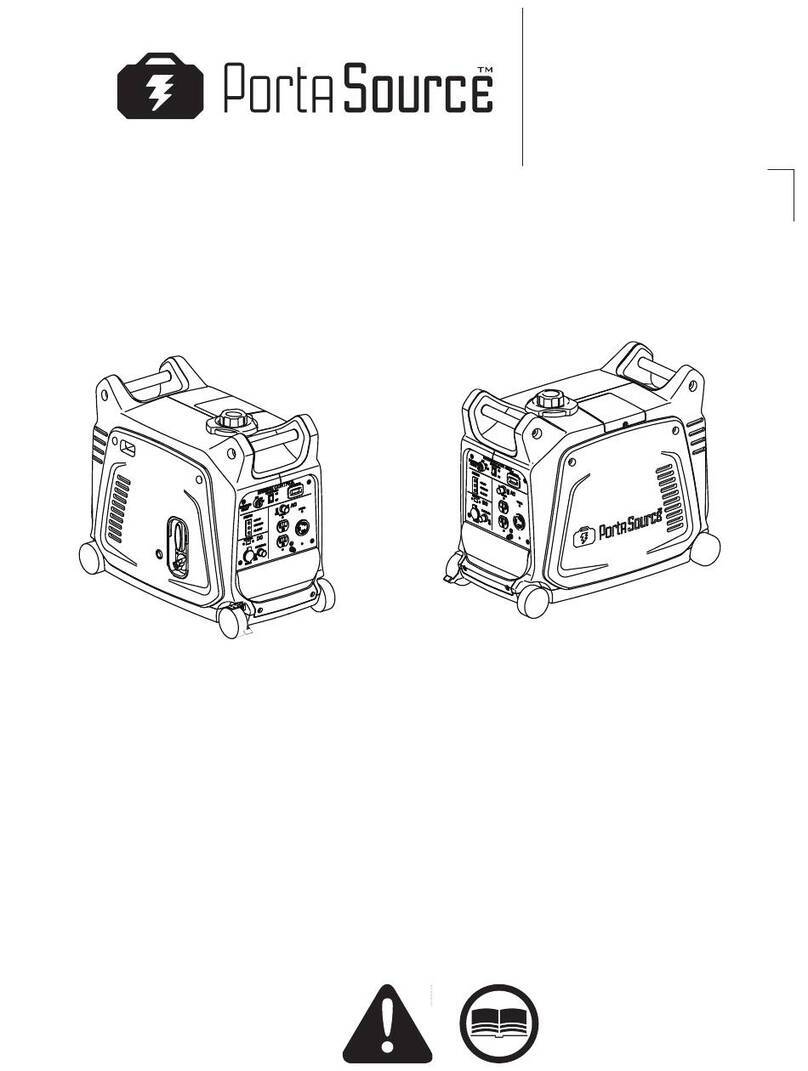
Porta Source
Porta Source IG3200W Operator's manual
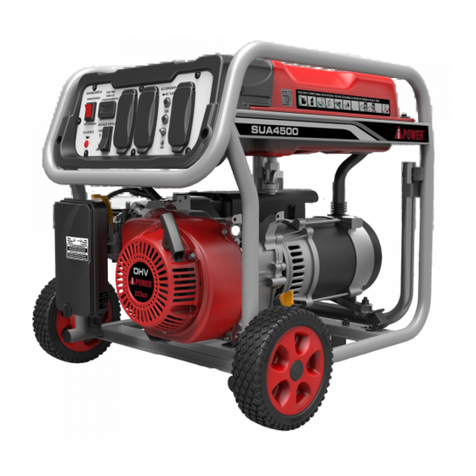
iPower
iPower SUA4500 owner's manual
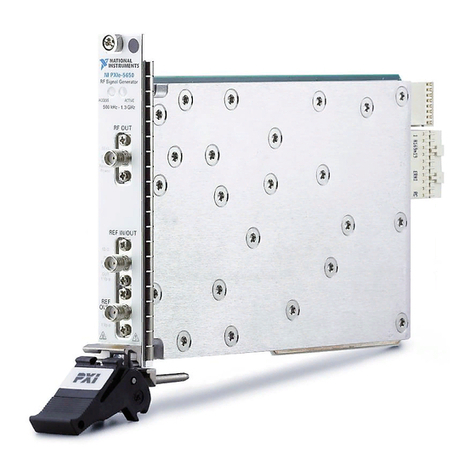
National Instruments
National Instruments PXIe-5650 Getting started guide
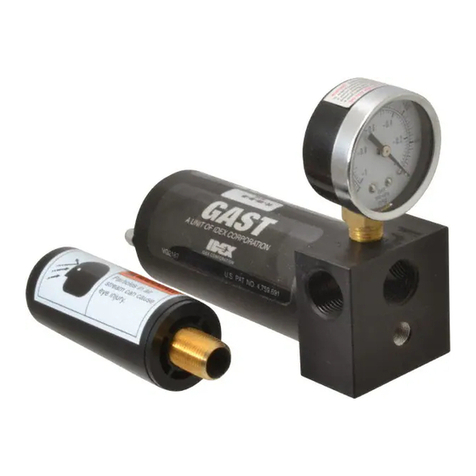
Idex
Idex Gast VG-007-00-00 Installation & operation instructions
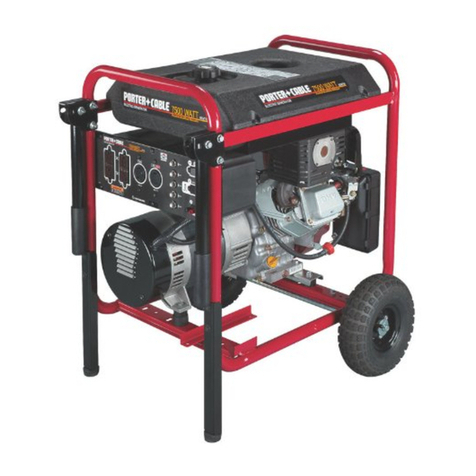
Porter-Cable
Porter-Cable BSV750 instruction manual
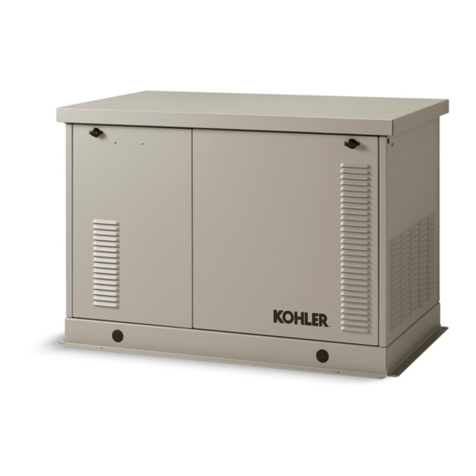
Kohler
Kohler 8.5RES Operation and installation
